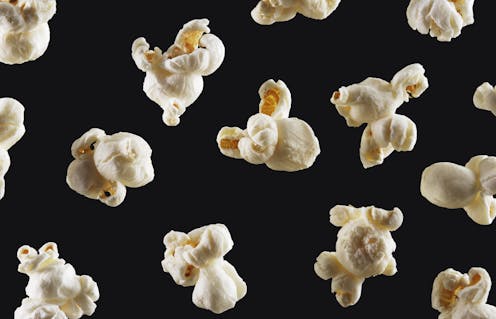How was popcorn discovered? An archaeologist on its likely appeal for people in the Americas millennia ago
- Written by Sean Rafferty, Professor of Anthropology, University at Albany, State University of New York

Scientists are pretty sure they know how old maize is. We know maize was probably first farmed by Native Americans in what is now Mexico. Early farmers there domesticated maize from a kind of grass called teosinte[10].
Before farming, people would gather wild teosinte and eat the seeds, which contained a lot of starch, a carbohydrate like you’d find in bread or pasta. They would pick teosinte with the largest seeds and eventually started weeding and planting it. Over time, the wild plant developed into something like what we call maize today. You can tell maize from teosinte by its larger kernels.
There’s evidence of maize farming from dry caves in Mexico as early as 9,000 years ago[11]. From there, maize farming spread throughout North and South America.
Popped corn, preserved food
Figuring out when people started making popcorn is harder. There are several types of maize, most of which will pop if heated[12], but one variety, actually called “popcorn,” makes the best popcorn. Scientists have discovered phytoliths from Peru[13], as well as burned kernels, of this type of “poppable” maize from as early as 6,700 years ago.
You can imagine that popping maize kernels was first discovered by accident. Some maize probably fell into a cooking fire, and whoever was nearby figured out that this was a handy new way of preparing the food. Popped maize would last a long time and was easy to make.
Ancient popcorn was probably not much like the snack you might munch at the movie theater today. There was probably no salt and definitely no butter, since there were no cows to milk in the Americas yet[15]. It probably wasn’t served hot and was likely pretty chewy compared with the version you’re used to today.
It’s impossible to know exactly why or how popcorn was invented, but I would guess it was a clever way to preserve the edible starch in corn by getting rid of the little bit of water inside each kernel that would make it more susceptible to spoiling. It’s the heated water in the kernel escaping as steam that makes popcorn pop. The popped corn could then last a long time. What you may consider a tasty snack today probably started as a useful way of preserving and storing food.
Hello, curious kids! Do you have a question you’d like an expert to answer? Ask an adult to send your question to CuriousKidsUS@theconversation.com[16]. Please tell us your name, age and the city where you live.
And since curiosity has no age limit – adults, let us know what you’re wondering, too. We won’t be able to answer every question, but we will do our best.
References
- ^ Curious Kids (theconversation.com)
- ^ curiouskidsus@theconversation.com (theconversation.com)
- ^ cassava plant is toxic (theconversation.com)
- ^ contaminated with bacteria (theconversation.com)
- ^ decays pretty quickly (www.nps.gov)
- ^ archaeologists like me (scholar.google.com)
- ^ very dry places that preserve it (doi.org)
- ^ rock-like fragments called phytoliths (doi.org)
- ^ vainillaychile/iStock via Getty Images Plus (www.gettyimages.com)
- ^ kind of grass called teosinte (www.nativeseeds.org)
- ^ as early as 9,000 years ago (doi.org)
- ^ most of which will pop if heated (www.wiley.com)
- ^ phytoliths from Peru (doi.org)
- ^ Rick Madonik/Toronto Star via Getty Images (www.gettyimages.com)
- ^ no cows to milk in the Americas yet (sentientmedia.org)
- ^ CuriousKidsUS@theconversation.com (theconversation.com)
Authors: Sean Rafferty, Professor of Anthropology, University at Albany, State University of New York


